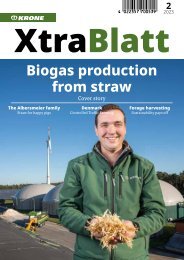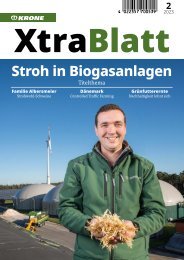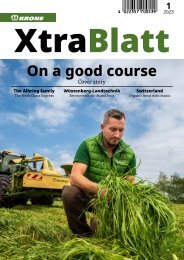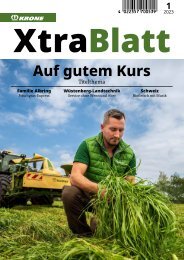XtraBlatt Issue 02-2017
You also want an ePaper? Increase the reach of your titles
YUMPU automatically turns print PDFs into web optimized ePapers that Google loves.
When we visited the Bigler farm<br />
a few months ago, Germany<br />
was still badly affected by the poor milk<br />
price year. We were therefore inquisitive<br />
about the milk production situation for<br />
producers in “cheese land” Switzerland.<br />
“It’s bad here too”, answered Rudolf Bigler.<br />
“Our farmers hope for a rise in prices<br />
although, honestly, I don’t think this will<br />
happen so soon.”<br />
THE CHEESE<br />
DELIVERS<br />
In Switzerland, milk price is not quite milk<br />
price, says Rudolf Bigler describing the<br />
Swiss confederation system. A third of<br />
the farmers, mainly in West Switzerland,<br />
deliver hay milk for more easily marketed<br />
cheeses (e.g. Gruyere) and get decent<br />
prices. In spring <strong>2017</strong> this was 85 rappen<br />
(Rp)/l which represented 74 Eurocents.<br />
(NB: 100 Rp = 1 Swiss Franc or CHF). One<br />
third get acceptable prices (57 ct/kg) e.g.<br />
for Emmental cheese, and a final third<br />
must accept a price equivalent to just<br />
under 44 ct for processing and industry<br />
milk. While the prices have risen on average<br />
by 5 Rp/l during the summer, they<br />
are still not in the proverbial green area.<br />
“Put simply, the milk price depends on the<br />
market success of the cheese types,” explains<br />
Rudolf Bigler.<br />
The Bigler family’s cow barn is fully automatic with robots milking and feeding cows, followers<br />
and calves.<br />
In Switzerland, the milk price system isn’t<br />
easily understood. The farmer told us<br />
about the different price levels: A, B and<br />
C milk. He has, for example, a monthly<br />
contract for a certain amount of A milk<br />
from his farm. When he steps over this<br />
amount, the oversupply automatically<br />
slips into the B price range, or even C sector.<br />
That’s not all: this contract amount<br />
is flexible, varying according to amount<br />
of milk produced in a particular season.<br />
Highest deliveries are in March, April and<br />
May leading to milk oversupply which<br />
then depresses the contractual amount<br />
of A milk. Thus, Bigler must accept that,<br />
from March to May, more of his milk slips<br />
into the B and C categories. In summer,<br />
when milk deliveries are less, the sizes of<br />
A and B milk contracts can increase.<br />
SELF<br />
MARKETING PAYS<br />
“Future-oriented dairy farmers must plan<br />
their costs for survival with a milk price of<br />
around 50 Rp,” reckons this Moosseedorf<br />
farmer somewhat provocatively. However,<br />
he knows very well that most farms<br />
won’t manage this and will have to part<br />
with their cows. This is already obvious<br />
from the structural changes in his area.<br />
“When I was a student 30 years ago there<br />
were 17 dairy farmers in our village. Now,<br />
there are only two of us left.”<br />
For background, it’s important to realise<br />
that the average dairy farm in Canton<br />
Bern milks 20 cows on 20 ha land. And<br />
that direct payment support is according<br />
to land area. Bigler points out that<br />
this means farmers will part with their<br />
cows before they sell any land. With a<br />
20-ha farm and relatively little work, up<br />
to 30,000 CHF subsidy can be achieved,<br />
he smiles. The state pays more premium<br />
per ha than the rent required for the land<br />
which lies, according to Rudolf Bigler, at<br />
just short of 880 € equivalent, while state<br />
subsidy often reaches 1400 €/ha. “This<br />
blocks the structural change and sets false<br />
signals,” he reckons.<br />
Swiss farmers wanting to make money<br />
with milk must, alongside watching production<br />
costs, also especially choose the<br />
right marketing strategy. This means<br />
milk for cheese, and not milk for export.<br />
On the other hand, cheese is not always<br />
43
















